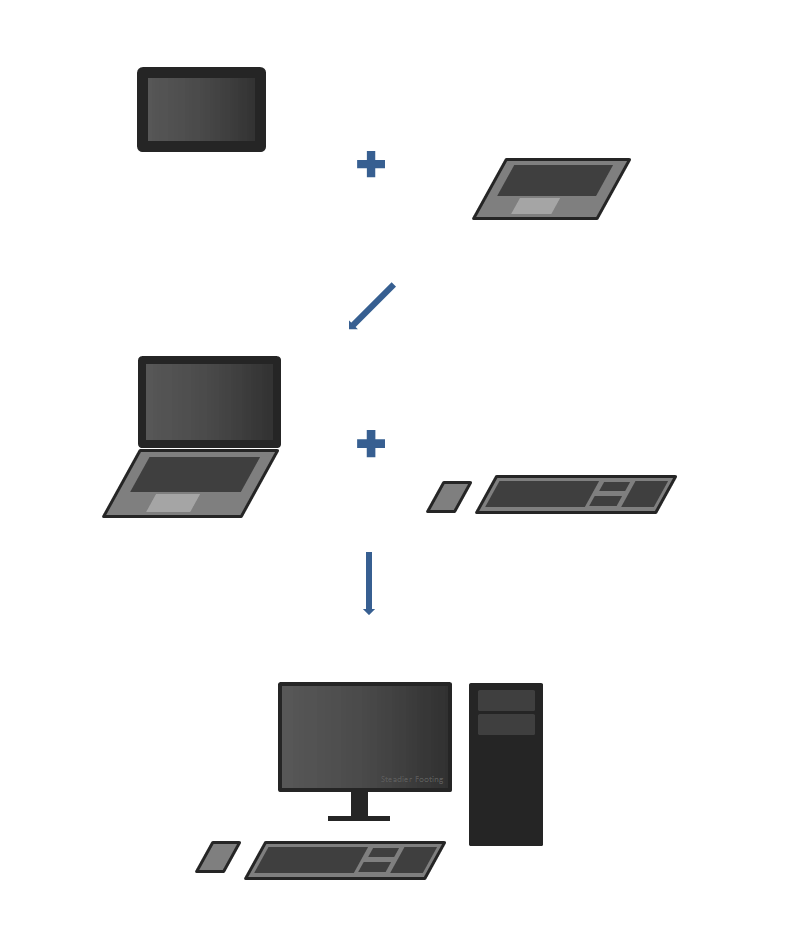Tablets are not Post-PC devices
Some people argue that a tablet is a completely separate class of computing device than a laptop. Others argue that a tablet is a consumption device and not a production device. I think both ideas are a bit wrong, or at least a bit off. Because of the tablet’s primary input mechanism, the touchscreen, people seem be willing to spin it into a new category of devices. I don’t think that distinction is really needed, or particularly useful in most cases. Just like its predecessors, the tablet is a personal computer. That’s all it is. It’s not a post-PC device.
Tablets are essentially an evolution of the desktop PC; they are the descendants of laptops. Tablets are to laptops what laptops are to desktops. This might sound ridiculous at first glance, but that’s okay, your eyes just deceive you. Maybe a more detailed comparison will be more persuasive.
Let’s start with the venerable desktop PC. It’s basically four basic units: the chassis, the monitor, the keyboard, and the mouse. It takes a lot of space (comparatively), and it always needs to be plugged in. It always stays in the same place, probably on some desk in some dark room. The desktop was followed by the laptop. The four units became two units: the display connected to everything else. The primary input method changed from a mouse to a touchpad. The PC became smaller. It became portable. Instead of sitting at one place, you could take your work anywhere you want. Instead of sitting at that desk, bring it to a coffee shop while you enjoy the pretty girls passing by. Then came the tablets. The two units became just one unit: the display and everything else. The primary input method changed from a touchpad to a capacitive touchscreen. The battery life became longer. The size became smaller. Now instead of working comfortably from a coffee shop, you can work comfortably in confined spaces: airplane seats, toilet seats, wherever.
Now I want to point out why all three devices are essentially the same thing, a personal computer. Each of the smaller devices can effectively “become” the larger device at any time. Connecting a laptop to a keyboard, mouse, and display will effectively make it into a desktop. Similarly, for a tablet, connecting a keyboard and touchpad will make it into a laptop. Going further, connecting a monitor as well will effectively make it into a desktop. Looking at it this way, these devices are not different classes of devices; they are just new form factors of the same device, the personal computer.
Each new form factor follows the similar trend: a new input method, a smaller but usable output, much greater portability, and the ability to become the larger form factor. Each form factor is also, initially at least, much less powerful than its predecessor. However, we know that within a few years, most of the work that could only be done in the older device can be accomplished in the newer device. That is just a function of platform maturity 1.
So when we look at the three devices through this lens, as three different form factors of the same device, it becomes apparent that these are not complementary devices, but competitive devices. The newest form factor will consume the market share of the older form factor. It took laptops a while, but now they easily outsell desktops, especially to consumers. I’m sure we’ll see the same trend in 3-5 years in the laptop-tablet market, when laptops will cede their majority share to tablets2.
I just posited that the tablet form factor is a personal computer. However, I left off any discussion of the second part of the equation: software3. Although I do think the tablet is a PC, it’s perception as one by the market will be determined by the software that runs on it. Currently, there are three platforms of interest in the market: iOS, Android and its forks, and Windows. The failures and success of the three platforms will probably determine how the tablet is perceived in the long run: as a full-fledged PC or some sort of post-PC device.
Further Reading
I actually haven’t defined what a post-PC device is. I’m saving that for another post, with a discussion of software. There really isn’t a concrete definition of what a post-PC device is. We know Apple introduced the term “post-PC” device, but I’d argue the trends were set by other companies long before Apple’s announcement. One article that tries to answer the question is “What’s a Post-PC device” by Horace Dediu. He mostly talks about hardware, and much more succinctly than me, but the conclusions (he calls them consequences) are very similar.
I thought the article “One Year Later, the iPad Is Still My Favorite Computer” by Harry McCracken reinforces my point about a tablet being a PC. It covers all the pluses and minuses of this new form factor very well.
Footnotes
-
There is always some sort of outlier work, typically computationally heavy work, which is most efficiently done on a powerful machine, such as a desktop workstation. ↩
-
It might even be faster. We can see some some results from Q1 2012 at Asymco. ↩
-
Software, from the major players: Apple, Amazon, Google, and Microsoft deserves a much larger discussion, which I’ll save for a later date. ↩
